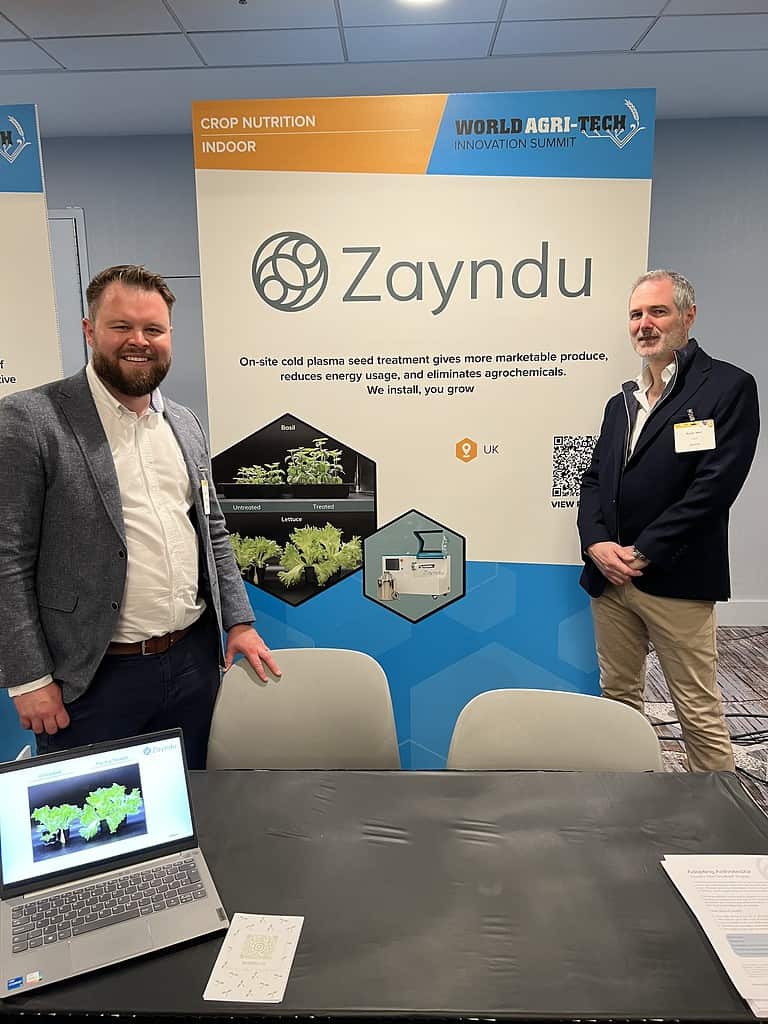Agrochemicals: Are They a Hoax?

Indoor Ag-Con is more of an exhibition with a conference aimed at the vertical farming, greenhouse, and controlled environment sectors, while the World AgriTech Innovation Summit has a much wider remit and is more of a conference with an exhibition alongside.
Both events saw a steady flow of visitors to the Zayndu booth, eager to learn more about our seed activation technology.
Zayndu has developed the world’s first cold plasma seed treatment system, called ActiviatedAir. The process treats and primes seeds, which results in synchronised germination and enhanced plant growth.
When used in commercial systems, growers typically see yield increases of 15-25%.
“Practically, this means more marketable produce at the end of a crop cycle,” says our CEO Ralph Weir. “Some growers also report being able to shorten their production cycles because the crop gets going quicker.
“We have had some exciting conversations with existing and prospective customers. ActivatedAir is already being used by some of the biggest vertical farming companies globally, but the beauty of our system is its vast applications.”
Perhaps surprisingly, given the events were held in the US, there was a distinct resurgence of interest from vertical farm businesses at the events.
Over the past couple of years, vertical farming has become somewhat of a toxic phrase in the US, Ralph suggests.
“There’s been a transatlantic split in the perception of vertical farms, partly because of the difference in funding sources between Europe and America,” he explains.
“Europe is more conservative when it comes to funding new technology than in the US. When someone says I’m going to build a vertical farm in Europe, the venture capital funds tend to suggest you talk to someone else about funding, and that means vertical farms have been funded by infrastructure funds in Europe.”
Ralph points out that in the US, technology venture capital funds have invested in vertical farms, which has resulted in different expectations of how quickly the businesses will grow.
Technology venture capitalists are used to seeing a new app with 50 sales a month going to 5000 very quickly, he says.
“That’s real in technology, but not with plants or in the big infrastructure projects you need to build a vertical farm.”
The result, when energy price hikes hit, was that many of the vertical farms in the US either significantly downsized or filed for bankruptcy under Chapter 11.
In contrast, in Europe and the UK, companies such as Grow Up Farms, Jones Food Company, and Fischer Farms are all doing reasonably well because of the different funding backgrounds and mentalities.
“But the failures in the US affected the sentiment towards vertical farms across the world,” Ralph notes.
However, at recent events, Ralph detected a more positive mood around vertical farms in the US, with more enquiries from vertical farm businesses interested in using Zayndu technology.
“It’s good news as we have machines with drum capacities optimized for vertical farms, as well as big greenhouse operators and indoor growers.”
On a smaller scale, there was also interest from visitors who were effectively selling a vertical farm consumer appliance, Ralph adds.
“This is like a fridge-freezer-sized appliance with a glass door in which you put yoghurt-sized pots with a growing media and a few seeds. The machine then uses artificial intelligence to water the seeds and monitor things like humidity and light to grow crops such as lettuce and radish.
“The requirements for our ActivatedAir seed priming are low because it doesn’t really matter how many of those machines you have. You’re still at the consumer level; it’s just little packets of seeds.”
Other visitors were also interested in our technology’s small-batch capabilities. For example, those growing specialty seeds, such as ornamentals, where relatively low numbers of seeds are produced of a high number of different varieties, or high-value crops, such as tomatoes, peppers, and cucumbers.
“We built a number of new relationships at the event for these types of businesses,” Ralph concludes.

Agrochemicals: Are They a Hoax?









Zayndu Limited
Advanced Technology Innovation Centre,
Loughborough University Science & Enterprise Park
5 Oakwood Drive, Loughborough, LE113QF UK
T: +44 (0) 1509 276225